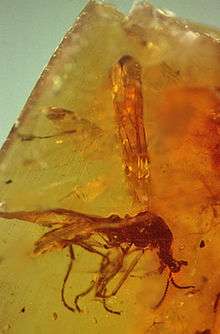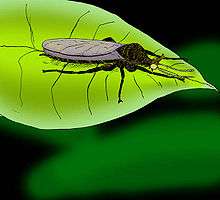Cascoplecia
| Cascoplecia Temporal range: Late Aptian to Early Cenomanian | |
|---|---|
 | |
| holotype fossil | |
| Scientific classification | |
| Kingdom: | Animalia |
| Phylum: | Arthropoda |
| Class: | Insecta |
| Order: | Diptera |
| Infraorder: | Bibionomorpha |
| Family: | Cascopleciidae Poinar Jr., 2010 |
| Genus: | Cascoplecia Poinar Jr., 2010 |
| Species: | C. insolitis |
| Binomial name | |
| Cascoplecia insolitis Poinar Jr., 2010 | |
Cascoplecia insolitis, commonly known as the unicorn fly,[1] is an extinct dipteran that lived in the Early Cretaceous. The type specimen was found in Burmese amber.[1] George Poinar, Jr., who described this fossil, coined a new family name for it – Cascopleciidae. One of the defining characteristics of Cascoplecia are three ocelli raised on an extended horn-like protuberance (hence its common name).

reconstruction
References
- 1 2 Poinar Jr., George (2010). "Cascoplecia insolitis (Diptera: Cascopleciidae), a new family, genus, and species of flower-visiting, unicorn fly (Bibionomorpha) in Early Cretaceous Burmese amber". Cretaceous Research. 31 (1): 71–76. doi:10.1016/j.cretres.2009.09.007.
This article is issued from Wikipedia - version of the 5/30/2016. The text is available under the Creative Commons Attribution/Share Alike but additional terms may apply for the media files.